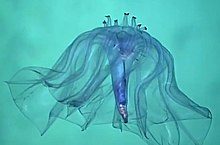
Sea cucumbers are echinoderms from the class Holothuroidea. They are marine animals with a leathery skin and an elongated body containing a single, branched gonad. Sea cucumbers are found on the sea floor worldwide. The number of holothurian species worldwide is about 1,717, with the greatest number being in the Asia-Pacific region. Many of these are gathered for human consumption and some species are cultivated in aquaculture systems. The harvested product is variously referred to as trepang, namako, bêche-de-mer, or balate. Sea cucumbers serve a useful role in the marine ecosystem as they help recycle nutrients, breaking down detritus and other organic matter, after which bacteria can continue the decomposition process.

Scotoplanes is a genus of deep-sea sea cucumbers of the family Elpidiidae. Its species are commonly known as sea pigs.

Isostichopus fuscus, commonly known as the brown sea cucumber, is a species of sea cucumber in the family Stichopodidae native to the eastern Pacific. It was first described to science by German biologist Hubert Ludwig in 1875.

NOAAS Okeanos Explorer is a converted United States Navy ship, now an exploratory vessel for the National Oceanic and Atmospheric Administration (NOAA), officially launched in 2010. Starting in 2010, NOAA entered into a five-year partnership with the San Francisco Exploratorium. The focus is on gathering scientific information about oceans for the public as well as for scientific uses. As much as 95% of the ocean remains unexplored, NOAA officials said. The ship is equipped with cameras and will provide real-time viewing of the ocean floor for scientists and for the public.

Holothuria atra, commonly known as the black sea cucumber or lollyfish, is a species of marine invertebrate in the family Holothuriidae. It was placed in the subgenus Halodeima by Pearson in 1914, making its full scientific name Holothuria (Halodeima) atra. It is the type species of the subgenus.

Enypniastes is a genus of deep-sea sea cucumber. It is monotypic, being represented by the single species Enypniastes eximia. Due to its unique appearance, the species has been dubbed the headless chicken fish, headless chicken monster, and the Spanish dancer. It is also known as the swimming sea cucumber, and some are called the pink see-through fantasia.

Elasipodida is an order of sea cucumbers. They have numerous appendages, including conical papillae and leaf-like tentacles. Although many species are benthic, a number are pelagic, and may have their appendages modified to form sails or fins. Most members of the order inhabit deep-sea environments, such as the species of the genus Enypniastes.

Psychropotes longicauda is a species of sea cucumber in the family Psychropotidae. It inhabits the deep sea where the adult is found on the seabed. The larva is pelagic and has an appendage shaped like a sail on its back which may enable it to move through the water.

Pelagothuriidae is a family of deep-sea swimming sea cucumbers. They are somewhat unusual in appearance, in comparison with other sea cucumbers, having numerous appendages, including conical papillae and leaf-like tentacles. Most of them are benthopelagic, which means that they are able to swim for a time from the bottom : the species Pelagothuria natatrix is the only true pelagic holothurian ; it looks like a jellyfish. Most members of the order inhabit deep-sea environments, like Enypniastes.

Astrosarkus idipi is a species of sea stars in the family Oreasteridae. It is the sole species in the genus Astrosarkus. It is sometimes referred to as a "Pumpkin sea star".

Pearsonothuria is a genus of sea cucumbers in the family Holothuriidae. Pearsonothuria graeffei is the only species in the genus. Graeffe's sea cucumber is found in the tropical Indo-Pacific Ocean and the type locality is Viti Island, Fiji.

Lissocarcinus orbicularis, common names sea cucumber crab, red-spotted white crab, and harlequin crab is a species of crab in the family Portunidae. This species gains one of its names from its close-knit relationship with holothuroids, the sea cucumbers. L. orbicularis should not be confused with L. laevis, a similar species of swimming crab, or Camposcia retusa, both of which are also commonly referred to as the harlequin crab. L. orbicularis displays numerous morphological and social adaptations for feeding and has a large distribution throughout the Indo-West Pacific.

Evoplosoma is a genus of deep-sea sea star in the family Goniasteridae.

Myriotrochidae is a family of sea cucumbers.

Hippasteria muscipula is one of twelve species of deep-sea sea star in the genus Hippasteria, which is in the family Goniasteridae.

Molpadia musculus is a species of sea cucumber in the family Molpadiidae. It is found in deep waters in the Atlantic Ocean, burrowing in the mud.

Psychropotidae is a family of deep-sea swimming sea cucumbers. The geographic range of some psychropotids is very extensive at abyssal depths, whereas other species are found within more restricted ranges.

Benthodytes is a genus of sea cucumbers in the family Psychropotidae.

Holothuria (Platyperona) difficilis is a species of sea cucumber in the family Holothuriidae. Holothuria comes from Latin but is originally taken from Greek. Its meaning is a plantlike animal whose origin is uncertain.
Holothuria (Cystipus) cubana is a species of sea cucumber in the family Holothuriidae. This species was first described by Ludwig in 1875.






















